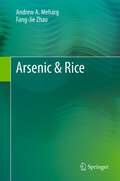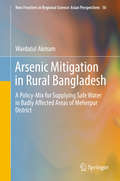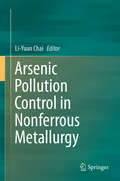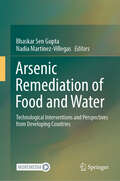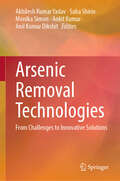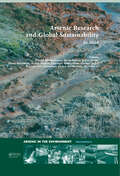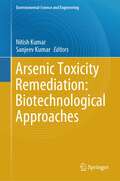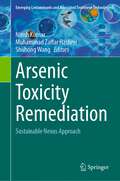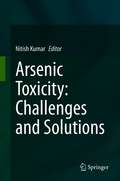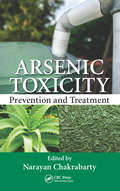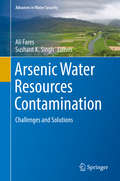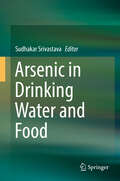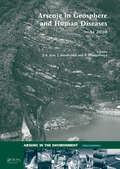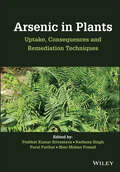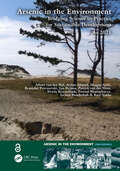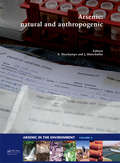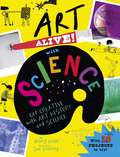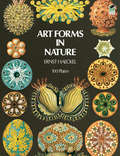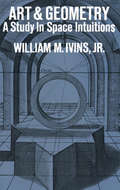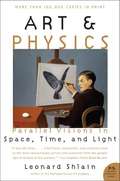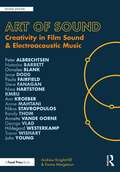- Table View
- List View
Arsenic & Rice
by Andrew A. Meharg Fang-Jie ZhaoRice is the staple food for half of the world's population. Consumption of rice is the major exposure route globally to the class one, non-threshold carcinogen inorganic arsenic. This book explains the sources of arsenic to paddy soils and the biogeochemical processes and plant physiological attributes of paddy soil-rice ecosystems that lead to high concentrations of arsenic in rice grain. It presents the global pattern of arsenic concentration and speciation in rice, discusses human exposures to inorganic arsenic from rice and the resulting health risks. It also highlights particular populations that have the highest rice consumptions, which include Southern and South East Asians, weaning babies, gluten intolerance sufferers and those consuming rice milk. The book also presents the information of arsenic concentration and speciation in other major crops and outlines approaches for lowering arsenic in rice grain and in the human diet through agronomic management.
Arsenic Mitigation in Rural Bangladesh: A Policy-Mix for Supplying Safe Water in Badly Affected Areas of Meherpur District (New Frontiers in Regional Science: Asian Perspectives #16)
by Wardatul AkmamBased on micro-level empirical research, this book uniquely addresses the problem of arsenic contamination in ground water in Bangladesh in a comprehensive way. At the outset, the book puts forward the opinions of experts regarding the cause of arsenic contamination in ground water in Bangladesh, followed by sample surveys depicting socioeconomic and arsenic-related situations in three arsenic-affected villages in Meherpur district, Bangladesh. The major contribution of the author is the mixed-integer Pareto optimality model (tested and proved through computer simulation), developed in order to supply safe water to the badly affected people in Taranagar village. The model takes into account such issues as the costs of different safe water options, exposure to arsenic and bacteria, distance of the water source from home, indigenous cultural traits, environmental safety and acceptability of the options to the people. Besides successful development and application of the model, the book outlines ways to persuade people to change their habits regarding drinking tube-well water and proposes a system through which safe water can be supplied to Taranagar village. The book emphasizes socioeconomic, environmental and administrative aspects of selecting an optimal safe water option and ensuring consumption from safe water sources, which can be tested for other arsenic-affected areas as well. With relevant, attractive charts, tables, graphs, flowcharts and other graphics and with lucid language, the book makes rather difficult theoretical economics issues easily comprehensible and interesting to general readers, graduate and undergraduate students, researchers and NGO/GO workers who are dedicated to providing safe water to people affected by arsenic contamination.
Arsenic Pollution Control in Nonferrous Metallurgy
by Li-Yuan ChaiThe control of arsenic pollution has attracted worldwide attention, as it is one of the top 20 hazardous substances, and greatly threatens the human health, ecological balance, and industrial development. Arsenic pollution results from natural enrichment and anthropological activities, especially mining and smelting operations. This book introduces arsenic pollution control technologies for aqueous solution and solid wastes produced by the utilization of arsenic-containing materials. It systematically discusses the principles and technologies of arsenic pollution control based on the author’s 16 years of research on arsenic, to help readers gain an understanding of various aspects of arsenic pollution control, including the pollution source distribution of arsenic in typical smelters, arsenic behaviors and pollution control technologies in aqueous solution and solid waste, and clean unitization of arsenic-containing materials.
Arsenic Remediation of Food and Water: Technological Interventions and Perspectives from Developing Countries
by Bhaskar Sen Gupta Nadia Martínez-VillegasThe book provides information on the sources of arsenic contamination of groundwater and their impacts in the first part of the book consisting of 8 chapters. Process developments such as nano-adsorbents for removal of arsenic and other heavy metals are discussed in the second part of the book that comprises of 4 chapters. The third part of the book includes 4 chapters on technological interventions for the removal of arsenic such as indigenous ceramic membranes and Subterranean Arsenic Removal (SAR). The fourth part of the book deals with arsenic contamination in food materials and food chain systems, and consists of 5 chapters. Arsenic has long been associated with a variety of health complications in the human body. In order to address this, a chapter on arsenic contamination and impacts on human health has been included in the fifth part of the book. The book would be a valuable reference material for the scientific community in developing countries working on community water supply and treatment, food safety, public health and policy.
Arsenic Removal Technologies: From Challenges to Innovative Solutions
by Ankit Kumar Anil Kumar Dikshit Monika Simon Akhilesh Kumar Yadav Saba ShirinThis book tackles the critical issue of arsenic contamination in water resources, a significant global threat impacting both developed and developing nations. Arsenic exposure poses severe health risks, including cancer, necessitating innovative solutions that prioritize both effectiveness and environmental responsibility. This book explores the diverse sources of arsenic contamination, from naturally occurring minerals to industrial pollutants, and the severe health impacts of chronic exposure, including cancer and cardiovascular diseases. It also covers the latest advancements in bioremediation and nanotechnology, featuring cutting-edge sustainable arsenic removal technologies that go beyond traditional methods like coagulation and filtration. Divided into 14 chapters, the book addresses topics such as bioremediation using microorganisms and natural plant-based systems, integrated bioremediation technologies, and the application of nanotechnology for enhanced efficiency and affordability. It also outlines the development and use of low-cost adsorptive materials and sustainable adsorbents, providing a comprehensive overview of their strengths, limitations, and future prospects. With a focus on both developed and developing countries, the book examines the current state of arsenic removal methods, the challenges faced, and the innovative solutions being developed. It highlights the importance of building capacity and knowledge sharing for sustainable arsenic management. This book is an essential resource for researchers, environmental scientists, engineers, and policymakers working in the fields of environmental science, water treatment, and public health. It equips readers with a detailed and up-to-date perspective on the technologies and strategies needed to effectively mitigate arsenic pollution.
Arsenic Research and Global Sustainability: Proceedings of the Sixth International Congress on Arsenic in the Environment (As2016), June 19-23, 2016, Stockholm, Sweden (Arsenic in the Environment - Proceedings)
by Jochen Bundschuh Prosun Bhattacharya Arslan Ahmad Ravi Naidu Marie Vahter Jerker Jarsjö Jurate Kumpiene Charlotte Sparrenbom Gunnar Jacks Marinus Eric DonselaarThe Congress "Arsenic in the Environment" offers an international, multi- and interdisciplinary discussion platform for research and innovation aimed towards a holistic solution to the problem posed by the environmental toxin arsenic, with considerable societal impact. The congress has focused on cutting edge and breakthrough research in physical, chemical, toxicological, medical, agricultural and other specific issues on arsenic across a broader environmental realm. The Congress "Arsenic in the Environment" was first organized in Mexico City (As2006) followed by As2008 in Valencia, Spain, As2010 in Tainan, Taiwan, As2012 in Cairns, Australia and As2014 in Buenos Aires, Argentina. The 6th International Congress As2016 was held June 19-23, 2016 in Stockholm, Sweden and was entitled Arsenic Research and Global Sustainability. The Congress addressed the broader context of arsenic research along the following themes:Theme 1: Arsenic in Environmental Matrices and Interactions (Air, Water, Soil and Biological Matrices)Theme 2: Arsenic in Food ChainTheme 3: Arsenic and HealthTheme 4: Clean Water Technology for Control of ArsenicTheme 5: Societal issues, Policy Studies, Mitigation and ManagementLong term exposure to low-to-medium levels of arsenic via contaminated food and drinking water can have a serious impact on human health and globally, more than 100 million people are at risk. Since the end of the 20th century, arsenic in drinking water (mainly groundwater) has emerged as a global health concern. In the past decade, the presence of arsenic in plant foods – especially rice – has gained increasing attention. In the Nordic countries in particular, the use of water-soluble inorganic arsenic chemicals (e.g. chromated copper arsenate, CCA) as wood preservatives and the mining of sulfidic ores have been flagged as health concern. The issue has been accentuated by discoveries of naturally occurring arsenic in groundwater, primarily in the private wells, in parts of the Fennoscandian Shield and in sedimentary formations, with potentially detrimental effects on public health. Sweden has been at the forefront of research on the health effects of arsenic, technological solutions for arsenic removal, and sustainable mitigation measures for developing countries. Hosting this Congress in Sweden was also relevant because historically Sweden has been one of the leading producer of As2O3 and its emission from the smelting industries in northern Sweden and has successfully implemented actions to reduce the industrial emissions of arsenic as well as minimizing the use of materials and products containing arsenic in since 1977. The Congress has gathered professionals involved in different segments of interdisciplinary research in an open forum, and strengthened relations between academia, industry, research laboratories, government agencies and the private sector to share an optimal atmosphere for exchange of knowledge, discoveries and discussions about the problem of arsenic in the environment and catalyze the knowledge generation and innovations at a policy context to achieve the goals for post 2015 Sustainable Development.
Arsenic Toxicity Remediation: Biotechnological Approaches (Environmental Science and Engineering)
by Nitish Kumar Sanjeev KumarArsenic contamination in drinking water and associated adverse outcomes is one of the major health issues in more than 50 countries worldwide. The scenario is getting even more detrimental with increasing number of affected people and newer sites reported from all over the world. Apart from drinking water, the presence of arsenic has been found in various other dietary sources. Threatening the health of millions of people due to arsenic’s toxicity and carcinogenicity, the major routes of arsenic exposure for humans are either through drinking water or crops. This edited volume brings together a diverse group of environmental science, sustainability, and health researchers to address the challenges posed by global mass poisoning caused by arsenic water contamination. The book sheds light on this global environmental issue and proposes solutions to aquatic contamination through multi-disciplinary sustainable approaches and case studies from different parts of world. This book addresses the problem of arsenic by pursuing a holistic approach. It presents the status quo in different parts of the world and provides essential information on food-related arsenic exposure risks for humans and possible preventive and curative measures for tackling arsenic poisoning. The mechanisms of arsenic uptake, translocation, and distribution in plants and grains are also explained. In closing, the book reviews a variety of prospective sustainable solutions to the problem of arsenic accumulation in soil and water.The book comprises three sections. First section describes the routes of exposure to environmental arsenic and its transport in soil and aquatic ecosystems including its source and distribution in specific locations. Second section explains the health risks linked to arsenic exposure in food and the environment. Third section addresses sustainable arsenic contamination mitigation strategies using the potential applications of recent biotechnological techniques, bioremediation, phytoremediation, genetic engineering, nanotechnology, and in silico approaches.The book is intended for a broad audience including researchers, scientists, and readers with diverse backgrounds including agriculture, environmental science, food science, environmental management, and human health. It can also be used as an important reference guide for undergraduate and graduate students, university faculties, and environmentalists. The book may serve as a reference to environment and sustainability researchers, students, and policy makers.
Arsenic Toxicity Remediation: Sustainable Nexus Approach (Emerging Contaminants and Associated Treatment Technologies)
by Nitish Kumar Muhammad Zaffar Hashmi Shuhong WangArsenic contamination in drinking water and crops is a major health issue in many countries worldwide, threatening the health of millions of people due to arsenic’s toxicity and carcinogenicity. This edited volume brings together a diverse group of environmental science, sustainability and health researchers to address the challenges posed by arsenic contamination. The book sheds light on this global environmental issue and proposes solutions to aquatic contamination through multi-disciplinary sustainable approaches and case studies from different parts of the world. The chapters contained here present the status quo in different parts of the world and provide essential information on arsenic exposure risks for humans as well as possible measures for tackling arsenic poisoning. The mechanisms of arsenic uptake, translocation and distribution in plants and grains are also explained. In closing, the book reviews a variety of prospective sustainable solutions to the problem of arsenic accumulation in soil and water. The book is comprised of three sections. The first section describes the routes of exposure to environmental arsenic and its transport in soil and aquatic ecosystems. The second section explains the health risks linked to arsenic exposure in food and the environment. The third section addresses sustainable arsenic contamination mitigation strategies using the potential applications of recent biological technology such as biotechnology, bioremediation, phytoremediation, biochar, absorbent, genetic engineering, and nanotechnology approaches. The book is intended for a broad audience including researchers, scientists, and readers with diverse backgrounds.
Arsenic Toxicity: Challenges and Solutions
by Nitish KumarArsenic (As) is a widely distributed element in the environment having no known useful physiological function in plants or animals. Historically, this metalloid has been known to be used widely as a poison. Effects of arsenic have come to light in the past few decades due to its increasing contamination in several parts of world, with the worst situation being in Bangladesh and West Bengal in India. This edited volume brings together diverse group of environmental science, sustainability and health researchers to address the challenges posed by global mass poisoning caused by arsenic water contamination. The book covers sources of arsenic contamination, and its impact on human health and on prospective remediation both by bioremediation and phytoremediation. Applications of advance techniques such as genetic engineering and nanotechnology are also discussed to resolve the issue of arsenic contamination in ground water and river basins. The book sheds light on this global environmental issue, and proposes solutions to remove contamination through a multi-disciplinary lens and case studies from Bangladesh and India. The book may serve as a reference to environment and sustainability researchers, students and policy makers. It delivers an outline to graduate, undergraduate students and researchers, as well as academicians who are working on arsenic toxicity with respect to remediation and health issues.
Arsenic Toxicity: Prevention and Treatment
by Narayan ChakrabartyThe most talked about metalloid in the modern world, arsenic affects the liver, kidney, and lungs; leads to cardiovascular diseases, cancer, and diabetes; and may cause blindness with long-time exposure. With naturally occurring arsenic boosted by mining and other industrial processes contaminating soil and drinking water, arsenic toxicity is a maj
Arsenic Water Resources Contamination: Challenges and Solutions (Advances in Water Security)
by Ali Fares Sushant K. SinghThis edited volume brings together a diverse group of environmental science, sustainability and health researchers to address the challenges posed by global mass poisoning caused by arsenic water contamination. The book sheds light on this global environmental issue, and proposes solutions to aquatic contamination through a multi-disciplinary lens and case studies from Bangladesh and India. The book may serve as a reference to environment and sustainability researchers, students and policy makers.Part one of the book describes the issue of arsenic contamination in ground water and river basins, including its source and distribution in specific locations in India. Part two explains the routes of exposure to environmental arsenic, its transport in aquatic ecosystems, and the health risks linked to arsenic exposure in food and the environment. Part three addresses sustainable arsenic contamination mitigation strategies and policies, the socioeconomic, demographic, cultural and psychological aspects of arsenic contamination, and the potential applications of GIS and remote sensing in providing solutions. Part four concludes by discussing the role of local and regional institutions in water resources management for a variety of issues including but not limited to arsenic contamination, and presents a case study in the Indus river basin in Pakistan to propose future contamination mitigation strategies.
Arsenic in Drinking Water
by National Research CouncilThe U.S. Environmental Protection Agency (EPA) has been considering a more stringent regulation of arsenic in water. A significant reduction in the maximum contaminant level (MCL) could increase compliance costs for water utilities. This book discusses the adequacy of the current EPA MCL for protecting human health in the context of stated EPA policy and provides an unbiased scientific basis for deriving the arsenic standard for drinking water and surface water.Arsenic in Drinking Water evaluates epidemiological data on the carcinogenic and noncarcinogenic health effects of arsenic exposure of Taiwanese populations and compares those effects with the effects of arsenic exposure demonstrated in other countries—including the United States.The book also reviews data on toxicokinetics, metabolism, and mechanism and mode of action of arsenic to ascertain how these data could assist in assessing human health risks from arsenic exposures. This volume recommends specific changes to improve the toxicity analyses and risk characterization. The implications of the changes for EPA’s current MCL for arsenic are also described.
Arsenic in Drinking Water and Food
by Sudhakar SrivastavaArsenic contamination poses a major environmental problem, especially in Southeast Asian countries like Bangladesh and India. Threatening the health of millions of people due to arsenic’s toxicity and carcinogenicity, the major routes of arsenic exposure for humans are either through drinking water or crops. Rice is the crop most affected by arsenic owing to its cultivation in major arsenic contaminated areas, biogeochemical factors in the soil during rice growth, and specific features of rice that enable it take up more arsenic than other crop plants. This book addresses the problem of arsenic by pursuing a holistic approach. It presents the status quo in different parts of the world (North and South America, Europe, Asia, etc.) and provides essential information on food-related arsenic exposure risks for humans, and possible preventive and curative measures for tackling arsenic poisoning. It covers the arsenic contamination status of rice, rice-based products, other vegetables, fishes, mushrooms, and other foods, with a special focus on rice-arsenic interactions. The mechanisms of arsenic uptake, translocation and distribution in plants and grains are also explained. In closing, the book reviews a variety of prospective agronomic and biotechnological solutions to the problem of arsenic accumulation in rice grains. The book is intended for a broad audience including researchers, scientists, and readers with diverse backgrounds including agriculture, environmental science, food science, environmental management, and human health. It can also be used as an important reference guide for undergraduate and graduate students, university faculties, and environmentalists.
Arsenic in Geosphere and Human Diseases; Arsenic 2010: Proceedings of the Third International Congress on Arsenic in the Environment (As-2010) (Arsenic in the Environment - Proceedings)
by Jochen Bundschuh Prosun Bhattacharya Jiin-Shuh JeanThe congress "Arsenic in the Environment" offers an international, multi- and interdisciplinary discussion platform for arsenic research aimed at short-term solutions of problems with considerable social impact, rather than only focusing on cutting edge and breakthrough research in physical, chemical, toxicological, medical and other specific issue
Arsenic in Plants: Uptake, Consequences and Remediation Techniques
by Parul Parihar Sheo Mohan Prasad Prabhat Kumar Srivastava Rachana SinghArsenic in Plants Comprehensive resource detailing the chemistry, toxicity and impact of arsenic in plants, and solutions to the problem Arsenic in Plants: Uptake, Consequences and Remediation Techniques provides comprehensive coverage of the subject, detailing arsenic in our environment, the usage of arsenicals in crop fields, phytotoxicity of arsenic and arsenic’s impact on the morphology, anatomy and quantitative and qualitative traits of different plant groups, including their physiology and biochemistry. The work emphasizes the occurrence of arsenic, its speciation and transportation in plants, and differences in mechanisms of tolerance in hyper-accumulator and non-accumulator plants. Throughout the text, the highly qualified authors delve into every facet of the interaction of arsenic with plants, including the ionomics, genomics, transcriptomics and proteomics in relation to arsenic toxicity, impact of exogenous phytohormones and growth-regulating substances, management of arsenic contamination in the soil-plant continuum, phytoremediation of arsenic toxicity and physical removal of arsenic from water. General discussion has also been included on subjects such as the ways through which this metalloid affects plant and human systems. Topics covered include: Introduction and historical background of arsenic and the mechanism of arsenic transport and metabolism in plants Arsenic-induced responses in plants, including impact on biochemical processes and different plant groups, from cyanobacteria to higher plants The role of phytohormones, mineral nutrients, metabolites and signaling molecules in regulating arsenic-induced toxicity in plants Genomic, proteomic, metabolomic, ionomic and transcriptional regulation during arsenic stress Strategies to reduce the arsenic contamination in soil-plant systems and arsenic removal by phytoremediation techniques Researchers, academics, and students of plant physiology, biotechnology, and agriculture will find valuable information in Arsenic in Plants to understand this pressing subject in full, along with its implications and how we can adapt our strategies and behaviors to promote reduced contamination through practical applications.
Arsenic in the Environment: Proceedings of the 8th International Congress and Exhibition on Arsenic in the Environment (As2021), June 7-9, 2021, Wageningen, The Netherlands (Arsenic in the Environment - Proceedings)
by Dragan Savic Jochen Bundschuh Prosun Bhattacharya Arslan Ahmad Ravi Naidu Branislav Petrusevski Jan Weijma Erwin Beerendonk van der Wal, Albert van der Wens, PatrickThe Congress and Exhibition Series "Arsenic in the Environment" offers an international, multi- and interdisciplinary discussion platform for research and innovation aimed towards a holistic solution to the challenges posed by the environmental toxin arsenic, with global societal impact. The Congress has focused on cutting edge and breakthrough research in physical, chemical, toxicological, medical, agricultural and other specific issues on arsenic across a broader environmental realm. The Biennial Congress and Exhibition "Arsenic in the Environment" was first organized in Mexico City (As2006) followed by As2008 in Valencia (Spain), As2010 in Tainan (Chinese Taiwan), As2012 in Cairns (Australia), As2014 in Buenos Aires (Argentina), As2016 in Stockholm (Sweden) and As2018 in Beijing (P.R. China).The 8th International Congress As2020 was held June 7-9, 2021 (first time digitally owing to the global COVID-19 pandemic, in Wageningen, The Netherlands) and with a title Arsenic in the Environment - Bridging Science to Practice for Sustainable Development. The Congress addressed the broader context of arsenic research aligned on the following themes:Theme 1: Arsenic in Natural Soil and Water SystemsTheme 2: Arsenic in Agriculture and Food ProductionTheme 3: Health Impacts of ArsenicTheme 4: Technologies for Arsenic Removal from WaterTheme 5: Sustainable Mitigation and Management for Sustainable DevelopmentArsenic in drinking water and food is a major health issue, affecting millions of people in many parts of the world. In recent years serious cases of arsenic exposure through different environmental matrices have been reported from, for example, Argentina, Bangladesh, Chile, China, Taiwan, Turkey, India, Mexico, UK, USA, Pakistan, Vietnam as well as other regions in the world. Arsenic can cause a number of carcinogenic and non-carcinogenic adverse effects on human health and therefore human exposure to arsenic should be avoided. Notably, The Netherlands has been in the forefront of research on arsenic removal technology and developed a cutting edge innovation to remove arsenic to levels below the WHO drinking water guideline to as low as less than 1 μg/L. This has created an enabling environment to discuss on policy issues for defining the new drinking water guideline. The Congress has attracted professionals involved in different segments of interdisciplinary research on arsenic in an open forum, and strengthened relations between academia, research institutions, government and non-governmental agencies, industries, and civil society organizations to share an optimal ambience for exchange of knowledge.
Arsenic: Natural and Anthropogenic (Arsenic in the environment)
by Jörg Matschullat Eleonora DeschampsThe discussion on arsenic in the environment is complex and must grasp the importance of very many, mostly unrelated works on individual aspects. This volume represents one of the first comprehensive and interdisciplinary examinations into arsenic's behaviour in air, water, soils, sediments, plants and the human body. Based on state-of-the-art investigations into the global arsenic cycle, the related human toxicology and available remediation technologies, arsenic is assessed holistically in all the environmental compartments. Using the results of primary research, the authors offer concrete suggestions for risk reduction and management of environmental pollution that allow the reader to successfully tackle similar problems and find sustainable solutions.
Art Alive! with Science: Get creative with art history and science!
by Mary AuldExperience how art meets science, from the earliest cave paintings to today's advanced tech - and meet the innovative artists behind it all!In Art Alive! with Science, award-winning author Mary Auld explores moments from art history that have expanded our understanding of the way things work, such as the beautiful balance of forces in kinetic sculpture, the interplay of light and shadow in painting and puppetry and how Op Art tricks our brains and plays with our senses. Following each case study of astounding innovation, there is a creative project that applies the scientific learning to the reader's own art practice. The unique art style of illustrator Sue Downing is sure to draw in young artists, especially alongside the photos of each artist's work and contribution to the timeline of innovation. Perfect for children age 8 and up.Artists and science principles inside include:Introduction: Artists and scientists from cave painting to bronze castingThe art of anatomy with Myron's Discobolus (Discus Thrower)The science of illustration with Hildegard of Bingen and Abd al-Rahman al-SufiThe fantasy of flight with Leonardo da VinciThe drama of light with Caravaggio's chiaroscuro and wayang kulit shadow puppetryThe art of nature with Ustad Mansur and Maria Sibylla MerianThe image in perspective with Johannes Vermeer's The GeographerThe science of clouds with Luke Howard, Caspar David Friedrich and John ConstableThe sense of colour with expressionism and pointillismThe structure of flowers with Georgia O'KeeffeThe energy of sound with Paul Klee's PolyphonyThe balance of forces with Alexander Calder's kinetic sculpturesThe art of astronomy with Galileo, Lucien Rudaux and NASAThe art of light with Pablo Picasso, Gjon Mili and their famous light drawing collaborationThe art of illusion with Marina ApollonioThe science of materials with Anish KapoorThe structures of life with Dorothy Hodgkin and Conrad ShawcrossThe reactions of chemistry with Cai Guo-Qiang's explosion eventsThe dimension of time with Jen's Stark's fascinating and mathematical 30 Cubed
Art Forms in Nature
by Ernst HaeckelErnst Heinrich Haeckel (1834-1919) was renowned as one of the foremost early exponents of Darwinism. His work was credited with having caused the acceptance of Darwinism in Europe, and his popular studies - preaching the continuity of all life, organic and inorganic, from prehistoric time to the present - converted tens of thousands of readers all over the world. Today, although no one is greatly interested in Haeckel the biologist-philosopher, his work is increasingly prized for something he himself would probably have considered secondary. These are the remarkable plates with which his work was illustrated, particularly his famous Kunstformen. The Kunstformen contains 100 beautiful lithographic plates which show a multitude of unusual life forms: Radiolaria, Foraminifera, and other forms of microscopic life; jellyfishes, starfishes, calcareous sponges, star corals, barnacles, and other sea life; mosses, lichens, red algae, ferns, fungi, orchids, and other plants; and turtles, moths, spiders, bats, frogs, lizards, hummingbirds, and antelope. With many drawings on each plate, each carefully drawn from nature, the subtle details of nature's art forms are easily compared and appreciated. In addition to being marvelous renderings, these plates have long been noted for the peculiar emotional appeal that they have for most viewers, a premonition of surrealism with exotic organic life forms stretching back to their roots in the inorganic, and individual details drawn with awareness of subtle evolutionary changes and millennia-long developments. Artists, illustrators, and others will find them still powerful as one of the landmarks of applied art.
Art and Geometry: A Study in Space Intuitions
by William M. IvinsOne of Western civilization's jealously guarded myths is that of Greek cultural supremacy. In this controversial study, William Ivins shows that the limitations of the Greek worldview actually hampered the development of the arts and sciences and gives a stimulating history of the new ideas of the Renaissance, especially in painting and geometry, that freed us from ancient misconceptions. Beginning with the Greeks, the author explains for the general reader the differences between ancient and Renaissance painting and sculpture, proving that the curiously static quality of Greek art arose from a misunderstanding of the laws of perspective. He then shows how this misunderstanding was corrected by Alberti, Pelerin, Durer, and other Renaissance artists who provided the first fruitful investigations of perspective. From there to projective geometry was but a step, and the author covers this major advance in our knowledge through the work of Nicholas of Cusa, Kepler, and Desargues. This book is perhaps the only concise history in English of the development of mathematical perspective and projective geometry. But the author's ability to relate styles in art to advances in geometry and his ingenious theory of the modern "visual" worldview and the Greek "tactile" worldview mean that his book will be provocative not only to mathematical historians but also to art historians and to anyone concerned with the history of thought, from philosopher to layman.
Art and Physics: Parallel Visions in Space, Time, and Light
by Leonard ShlainIn this book, Leonard Shlain explores how artistic breakthroughs could have prefigured the visionary insights of physicists on so many occasions throughout history. Art & Physics is a seamless integration of the romance of art and the drama of science--and an exhilarating history of ideas.
Art and Science in Breeding
by Margaret DerryChickens are now the most scientifically engineered of livestock. How have the methods used by geneticists differed from those employed by domestic breeders over time? Art and Science in Breeding details the relationship between farm practices and agricultural genetics in poultry breeding from 1850 to 1960.Margaret E. Derry traces the history and organization of chicken breeding in North America, from craft approaches and breeding as an 'art,' to the conflicts that had emerged between traditional and scientific methods by the 1940s. Derry assesses links between the 'scientific' revolution of chicken farming and the development of corporate breeding as a modern, international industry. Using poultry as a case study for the wider narrative of agricultural genetics, Art and Science in Breeding adds considerable knowledge to a rapidly growing field of inquiry.
Art in Science Museums: Towards a Post-Disciplinary Approach (Routledge Research in Museum Studies)
by Camilla Rossi-Linnemann Giulia De MartiniArt in Science Museums brings together perspectives from different practitioners to reflect on the status and meaning of art programmes in science centres and museums around the world. Presenting a balanced mix of theoretical perspectives, practitioners’ reflections, and case-studies, this volume gives voice to a wide range of professionals, from traditional science centres and museums, and from institutions born with the very aim of merging art and science practices. Considering the role of art in the field of science engagement, the book questions whether the arts might help curators to convey complex messages, foster a more open and personal approach to scientific issues, become tools of inclusion, and allow for the production of totally new cultural products. The book also includes a rich collection of projects from all over the world, synthetically presenting cases that reveal very different approaches to the inclusion of art in science programmes. Art in Science Museums should be of great interest to academics, researchers and postgraduate students working in the fields of museum studies, cultural heritage management, material culture, science communication and contemporary art. It should also be essential reading for museum professionals looking to promote more reflective social science engagement in their institutions.
Art in Science Museums: Towards a Post-Disciplinary Approach (Routledge Research in Museum Studies)
by Camilla Rossi-Linnemann Giulia De MartiniArt in Science Museums brings together perspectives from different practitioners to reflect on the status and meaning of art programmes in science centres and museums around the world.Presenting a balanced mix of theoretical perspectives, practitioners’ reflections, and case-studies, this volume gives voice to a wide range of professionals, from traditional science centres and museums, and from institutions born with the very aim of merging art and science practices. Considering the role of art in the field of science engagement, the book questions whether the arts might help curators to convey complex messages, foster a more open and personal approach to scientific issues, become tools of inclusion, and allow for the production of totally new cultural products. The book also includes a rich collection of projects from all over the world, synthetically presenting cases that reveal very different approaches to the inclusion of art in science programmes.Art in Science Museums should be of great interest to academics, researchers and postgraduate students working in the fields of museum studies, cultural heritage management, material culture, science communication and contemporary art. It should also be essential reading for museum professionals looking to promote more reflective social science engagement in their institutions.
Art of Sound: Creativity in Film Sound and Electroacoustic Music (Sound Design)
by Andrew Knight-Hill Emma MargetsonBringing together a diverse group of world leading professionals across Post-Production Film Sound and Electroacoustic Music, Art of Sound explores the creative principles that underpin how sonic practitioners act to compose, tell stories, make us feel, and communicate via sound. Revealing new understandings through analysis of interdisciplinary exchanges and interviews, this book investigates questions of aesthetics, perception, and interpretation, unveiling opportunities for a greater appreciation of the artistry in sound practice which underpins both experimental electronic music and the world’s leading film and television productions. It argues that we can better understand and appreciate the creative act if we regard it as a constantly unfolding process of inspiration, material action, and reflection. In contrast to traditional notions, which imagine outputs as developed to reflect a preconceived creative vision, our approach recognises that the output is always emerging as the practitioner flows with their materials in search of their solution, constantly negotiating the rich networks of potential. This enables us to better celebrate the reality of the creative process, de-centring technologies and universal rules, and potentially opening up the ways in which we think about sonic practices to embrace more diverse ideas and approaches. Art of Sound provides insight into the latest developments and approaches to sound and image practice for composers, filmmakers, directors, scholars, producers, sound designers, sound editors, sound mixers, and students who are interested in understanding the creative potential of sound.
